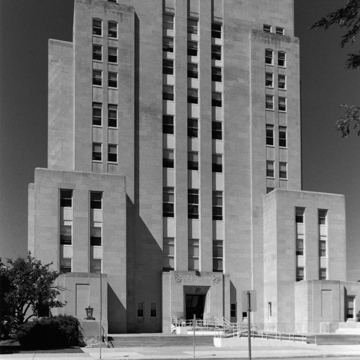Prominent Chicago architects Holabird and Root designed this eleven-story edifice, Racine’s most imposing landmark. With two low projections from its massive body, the courthouse looks a bit like a cubic sphinx. The symmetrical, stepped-back massing and vertical emphasis reflect the geometry of modernism. This building’s minimal ornamentation on its smooth Bedford limestone walls consists of stylized leaves and shields at the roofline and stylized civic symbols capping the pilasters. But in the entrance plazas and recessed entryways are sculptor Carl Milles’s spectacular bas-relief panels in the heroic Social Realism style of the 1930s. They depict people laboring, struggling through life stages, and grappling with nature’s elements. These panels were the internationally known Swedish immigrant’s first commission in the United States.
The courthouse’s interior is equally impressive. Images of animals and wheat trim the entrance doors, and geometric light fixtures illuminate the marble-lined lobby. The elevator doors—favorite decorative elements in the Art Deco vocabulary—are bronze, cast with personifications of Agriculture and Industry. First-floor courtrooms feature international hardwoods: Austrian and English oak, African and Mexican mahogany, and American butternut and walnut.


